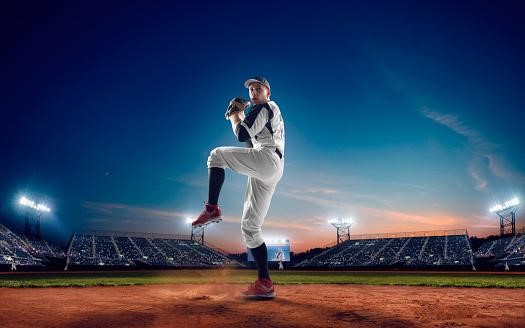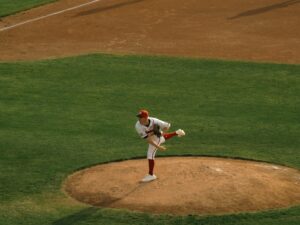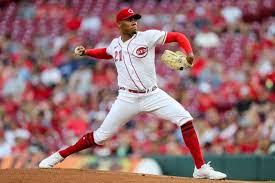Baseball is filled with exciting moments and impressive feats, but few things are as electrifying as a pitcher hurling a 100 MPH Fastball. This rare achievement showcases both sheer athleticism and mastery of technique, making the fastball a significant component in the arsenal of any successful pitcher.
As sports technology evolves and our understanding of pitching mechanics deepens, more and more players are striving to join the elite club of those capable of reaching the coveted 100 mph benchmark. Understanding the magnitude of a 100 mph fastball requires putting it into perspective.
From the moment a pitcher releases the ball until it reaches the plate, the fastball travels a distance of about 55 feet in a blistering 375 to 400 milliseconds.
To put that into context, an average human’s blink of an eye occurs in roughly the same time. This leaves the batter with only a fraction of a second to react and make contact with the incoming projectile.
Breaking the 100 mph mark has become a symbol of athletic prowess and a testament to the dedication and hard work exhibited by the top pitchers in the game.
While the fastball might not be the only weapon in a pitcher’s toolkit, it is a staple that commands respect from both teammates and opponents alike. As baseball continues to evolve, the pursuit of the elusive 100 mph fastball remains a captivating aspect of the sport.
Contents
History of the 100 MPH Fastball
Evolution of Pitching Techniques
In the early days of baseball, measuring the speed of a pitch was not possible. However, as the sport evolved, so did the techniques and abilities of pitchers.
Through improvements in training methods, strength and conditioning programs, and the introduction of new technology, pitchers have been able to increase the velocity of their fastballs over time.
During the 20th century, pitchers began to gain recognition for their increased fastball velocity, pushing the boundaries of what was once thought to be the limit.
The introduction of radar guns to measure pitch speed helped to quantify and validate these notable achievements, allowing for a better understanding of the effectiveness and impact of a 100 mph fastball.
Notable Pitchers
- Walter Perry Johnson: Born in 1887, Johnson was never officially recorded throwing a baseball at 100 mph or more, primarily due to the lack of measuring instruments at that time. However, the statistics and stories from his contemporaries suggest that his pitches were likely to reach those speeds, making him a key figure in the early days of high-velocity pitching.
- Nolan Ryan: Known as one of the hardest throwers in baseball history, Ryan’s fastball was officially recorded at 100.9 mph during a game against the Detroit Tigers on August 20th, 1974, becoming the fastest recorded pitch at that time. Ryan’s legendary fastball speed is still included in the Guinness Book of World Records.
- Steve Dalkowski: An enigmatic figure in baseball history, Dalkowski’s pitching speed was only recorded once in 1958 at 93.5 mph. While this speed may not seem as remarkable by today’s standards, the equipment used to measure it was rudimentary, and many believe that his actual pitching speed was likely much higher.
As the sport of baseball has continued to evolve, modern pitchers have consistently built upon the achievements of their predecessors. The 100 mph fastball has now become a benchmark for elite fastball throwers, showcasing both the physical prowess and mental fortitude required to be successful at the highest level of the game.
The Science Behind a 100 MPH Fastball
Pitching Mechanics
The ability to throw a 100 MPH fastball requires a combination of factors, which include exceptional pitching mechanics.
These allow the pitcher to generate enough force and speed on the baseball. The pitcher’s stride, arm action, and overall biomechanics play a vital role in reaching higher velocities.
- Stride Length: A longer stride allows the pitcher to maximize the force and torque generated by their lower body.
- Arm Action: A proper arm action includes an efficient arm whip, which allows the energy to be transferred from the pitcher’s body to their arm and eventually the baseball.
- Biomechanics: Proper biomechanics, such as hip and shoulder separation, help pitchers generate additional power and reduce stress on the arm.
Physiology of a Fastball Pitcher
Beyond pitching mechanics, the physiology of a fastball pitcher is crucial to achieving high velocities like 100 MPH.
Some of these physiological aspects include:
- Strength & Conditioning: Fastball pitchers often have a robust and well-conditioned musculoskeletal system that allows them to withstand the rigorous demands of throwing at high velocities without sustaining injuries.
- Flexibility: Increased flexibility helps pitchers achieve a proper range of motion in their joints, contributing to efficient energy transfer throughout their bodies and ultimately increasing pitch velocity.
- Neuromuscular Control: Fastball pitchers typically have superior neuromuscular control that allows them to execute precise and powerful movements during the pitching process.
- Reaction Time: A batter has less than 400 milliseconds to react to a 100 MPH fastball. Fastball pitchers rely on their ability to minimize the batter’s reaction time, making it harder for the hitter to make contact with the ball. Mental acuity and experience play a role in improving reaction time.
The science behind a 100 MPH fastball is not only fascinating but demonstrates the tremendous skill and physical ability required for a pitcher to reach such a milestone.
Both pitching mechanics and physiological factors contribute to the unique ability to throw these fast pitches.
Major League Baseball’s Fastest Fastballs
Record Holders
In Major League Baseball (MLB), a few pitchers stand out for their incredible fastball speeds. Aroldis Chapman currently holds the record for the fastest recorded pitch in MLB history.
On September 24, 2010, Chapman threw a 105.1 mph fastball, the first of its kind in the league.
However, in college baseball history, Ben Joyce holds the record for the fastest pitch. On May 1, 2022, Joyce threw a 105.5 mph ball for the Tennessee Volunteers.
While these record-breaking pitches are impressive, it is essential to note that fastball velocities have increased over the years. The average MLB fastball velocity in 2022 was 95.6 miles per hour, significantly faster than the average velocities in previous years.
Hardest Throwing Pitchers
- Nolan Ryan: Known for his exceptional fastball speed, Nolan Ryan had a long-lasting ability to consistently pitch at 100 mph or above during his 27-year career.
- Jordan Hicks: Hicks has the second-fastest fastball velocity average in the pitch tracking era, according to Baseball Savant, with his four-seam fastball averaging 100.8 mph.
- Hunter Greene: Greene is another promising pitcher who consistently throws fastballs well over 100 mph.
Hunter Greene, 101, 102 and 103mph (consecutive pitches to start the game). pic.twitter.com/qEORcOH7JU
— Rob Friedman (@PitchingNinja) March 3, 2021
These pitchers demonstrate the incredible talent and commitment it takes to throw high-velocity fastballs at the highest level of the sport. This accomplishment is a hallmark of elite pitchers in MLB, and it continues to amaze and entertain fans across the globe.
Notable 100 MPH Fastball Pitchers
Randy Johnson
Randy Johnson, also known as “The Big Unit,” was a left-handed pitcher known for his intimidating fastball, which regularly reached speeds of 100 miles per hour or more. Johnson’s incredible velocity allowed him to dominate opposing hitters throughout his 22-year Major League Baseball career. He is a 10-time All-Star and won the Cy Young Award five times. Johnson ranks second on the all-time strikeout list, and his signature pitch was a critical part of his success.
While many pitchers lose velocity as they age, Johnson managed to maintain his heat throughout his career, making him a remarkable and fearsome competitor on the mound. His exceptional height of 6 feet, 10 inches also played a role in generating the power needed for his high-velocity pitches.
Hunter Greene
Hunter Greene is a young and promising right-handed pitcher known for his ability to throw 100 miles per hour fastballs. Drafted by the Cincinnati Reds in 2017, Greene quickly gained attention for his exceptional velocity and raw talent. He has continued to develop his skills and is poised to become one of the top pitchers in the game.
In addition to his blazing fastball, Greene also boasts a strong repertoire of secondary pitches, including a slider and changeup, which helps to keep hitters off-balance. As he continues to mature and develop, his potential to dominate hitters with his speed and command will only grow.
Overall, both Randy Johnson and Hunter Greene have made significant impacts in the world of baseball with their impressive 100 miles per hour fastballs. These remarkable pitchers demonstrate the power and skill required to reach such elite velocities and serve as inspirations for future generations of pitchers aspiring to reach similar heights.
The Impact of a 100 MPH Fastball
Statistical Analysis
A fastball thrown at 100 miles per hour has a significant impact on the game of baseball, primarily due to the challenges it presents for hitters.
With pitches reaching home plate within just 400 milliseconds, batters face an incredibly narrow window to react and make contact with the ball. Combine this with the fact that the swing itself takes approximately 150 milliseconds, leaving as little as 250 milliseconds to make the split-second decision on whether or not to swing at the approaching pitch.
Moreover, as the velocity of these pitches has increased in recent years, a corresponding rise in strikeouts has been observed. This demonstrates the increased difficulty faced by batters as they strive to adjust to the unprecedented velocity of these pitches.
Dominance on the Field
The dominance of pitchers who can deliver a 100 MPH fastball is undeniable. By consistently reaching such high velocities, these pitchers put immense pressure on batters to make quicker decisions, especially when it comes to identifying the pitch type and location. As a result, many hitters try to “cheat” by starting their swings earlier, which can disrupt their timing and lead to more swinging strikes.
In addition to this, it is also clear that a rise in powerful fastballs has become the new normal for Major League Baseball pitchers, contributing to a higher number of strikeouts for opposing hitters. This, in turn, has led to an increased reliance on raw power, as opposed to finesse and control, which can make it even more challenging for batters to adapt and succeed in the face of such overwhelming velocity.
From High School to the Major Leagues
Scouting 100 MPH Fastball Pitchers
When it comes to discovering the next big pitching talent in high school, scouts often look for the ability to throw a fastball with high velocity.
This level of speed is a rare and highly sought-after attribute among Major League Baseball pitching prospects. The range of average pitching speed for an MLB player is between 90 and 100 miles per hour, but those who can consistently pitch at the higher end of that range are unique.
To find potential high-velocity pitchers, baseball scouts attend hundreds of high school games and showcase events. They closely observe pitchers and measure their fastball speed using radar guns. Furthermore, they evaluate their mechanics, physical attributes, and overall potential to succeed on a professional level.
It’s essential to note that a pitcher’s size does not play a significant role in their ability to throw 100 miles per hour fastballs.
Developing Top Pitching Prospects
Once a young pitcher with exceptional fastball speed is identified, they can be drafted into the minor leagues or begin development within a farm system.
This is where the hard work truly begins, as they work to hone their skills and polish their overall abilities on the mound. Key areas of focus include:
- Mechanics: Proper pitching mechanics are critical to maintaining high fastball velocity and avoiding injury. Coaches help young pitchers find the ideal balance between power and control, focusing on an efficient and consistent pitching motion.
- Strength and Conditioning: An essential aspect of developing a 100 mph fastball is building the necessary strength and stamina. Strength and conditioning programs tailored to each pitcher’s needs often include weightlifting, flexibility exercises, and overall endurance training.
- Mental and Emotional Toughness: For a pitcher to reach the Major Leagues, they must demonstrate not only physical prowess but also mental and emotional strength. This includes handling pressure, recovering from poor performances, and understanding how to adapt to various game situations.
- Secondary Pitches: While a 100 mph fastball is impressive, it’s essential for a well-rounded pitcher to have an arsenal of secondary pitches, such as curveballs, sliders, and change-ups. Developing these secondary pitches adds unpredictability and makes them a more effective and challenging opponent on the mound.
In summary, the journey from high school to the Major Leagues for a pitcher with a 100 mph fastball is not an easy one. It requires dedication, talent, perseverance, and constant improvement. With careful scouting, development, and training, these rare and gifted athletes have the potential to make a significant impact on the Major League level.
The Importance of Secondary Pitches
While a 100 mph fastball can be an impressive weapon in a pitcher’s arsenal, it is crucial for pitchers to have effective secondary pitches.
These pitches can make the difference between a dominating performance and an early exit from the game. Having a diverse pitch selection can keep hitters off balance, making the fastball even more effective. Some common secondary pitches include sliders, curveballs, changeups, and splitters.
Starters, in particular, rely on a mix of secondary pitches to navigate through lineups multiple times in a game. For example, a slider acts as a deceptive off-speed pitch that breaks laterally and moves away from the hitter. This makes it especially difficult for batters to make consistent contact if they are expecting a fastball.
In contrast, some relief pitchers specialize in one or two pitches, often relying on their dominant fastball as a primary weapon against hitters. However, even for relievers, having secondary pitches is vital to staying effective in the major leagues, allowing them the flexibility to adjust their approach based on the hitter they are facing.
Incorporating secondary pitches is not merely about having a diverse array of options but mastering them. Consistency in the release point, spin rate, and execution is essential to prevent batters from recognizing the pitch early and adjusting their swing.
Moreover, it is essential for pitchers to have the control and command of all their pitches to minimize walks and limit damage by keeping the ball in the ballpark.
To illustrate the importance of secondary pitches, here’s a table showing some popular pitch types and their corresponding average velocities:
| Pitch Type | Average Velocity (mph) |
|---|---|
| Fastball | 92.8 |
| Slider | 84.3 |
| Curveball | 77.1 |
| Changeup | 82.8 |
| Splitter | 84.2 |
By including secondary pitches in their repertoire, pitchers have the ability to mix speeds and movement, confuse hitters, and ultimately become more effective on the mound.





